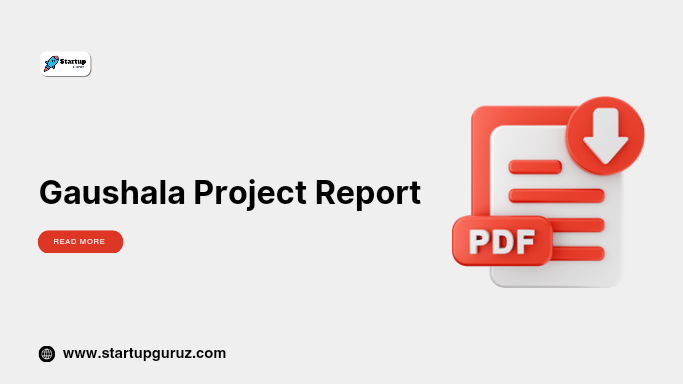Gaushala Project Report
Comprehensive Gaushala Project Report
A Gaushala is a shelter for cows, often established to protect and promote cow welfare. Gaushalas play a vital role in preserving indigenous cow breeds, promoting sustainable agricultural practices, and creating employment opportunities. With rising awareness about animal welfare and the cultural importance of cows in India, Gaushalas have become a promising initiative for individuals and organizations.
This report provides a detailed overview of setting up a Gaushala, its objectives, operational details, costs, benefits, and challenges. It also answers frequently asked questions for a better understanding of the project.

Importance of Gaushalas
Cultural and Religious Significance
In India, cows hold a sacred position and are often referred to as “Kamdhenu,” the wish-fulfilling divine cow. Gaushalas aim to provide safe shelter and care for abandoned, old, and sick cows, ensuring their well-being.
Agricultural Benefits
Cow dung and urine, valuable by-products of Gaushalas, are used in organic farming, bio-fertilizers, and biogas production, promoting sustainable agriculture.
Economic Impact
Gaushalas can generate income through milk production, sale of cow dung-based products, biogas, and organic fertilizers.
Objectives of a Gaushala
- Cow Protection: Rescue and provide care for stray and abandoned cows.
- Breed Conservation: Preserve and promote indigenous cow breeds.
- Sustainable Agriculture: Encourage the use of cow-based organic products.
- Community Support: Create jobs and provide training in animal husbandry.
Components of a Gaushala Project Report
1. Introduction
- Overview of the project.
- Objectives and vision of the Gaushala.
- Importance of cow protection and welfare.
2. Location and Infrastructure Requirements
- Suitable location with proper access to water, fodder, and grazing areas.
- Infrastructure for cow shelters, fodder storage, biogas units, and administrative offices.
Setup Requirements for a Gaushala
1. Land and Infrastructure
- Land Requirement: 1-3 acres for a medium-scale Gaushala.
- Facilities Needed:
- Cow sheds with adequate ventilation.
- Fodder storage units.
- Watering stations and waste management systems.
- Veterinary care facilities.
2. Cattle Procurement
- Rescue and adoption of stray cows.
- Purchase of indigenous cow breeds for milk production and breed conservation.
3. Fodder and Feeding
- Green fodder, dry fodder, and supplements.
- Hydroponic fodder systems for sustainable feeding.
4. Labor and Workforce
- Animal caretakers.
- Veterinary staff.
- Administrative and management personnel.
Financial Overview
Initial Investment
| Expense | Estimated Cost (₹) |
|---|---|
| Land acquisition | 10,00,000 – 20,00,000 |
| Construction of cow sheds | 15,00,000 – 25,00,000 |
| Fodder cultivation setup | 5,00,000 – 10,00,000 |
| Biogas plant and machinery | 7,00,000 – 12,00,000 |
| Veterinary equipment | 3,00,000 – 5,00,000 |
| Miscellaneous costs | 2,00,000 – 5,00,000 |
| Total Investment | 42,00,000 – 77,00,000 |
Operational Costs
| Expense | Monthly Cost (₹) |
|---|---|
| Fodder and supplements | 50,000 – 75,000 |
| Labor wages | 40,000 – 60,000 |
| Veterinary care | 10,000 – 20,000 |
| Utilities and maintenance | 15,000 – 25,000 |
| Total Monthly Cost | 1,15,000 – 1,80,000 |
Revenue Streams
| Product/Service | Revenue (₹) |
|---|---|
| Milk production (50 liters/day) | 75,000 – 1,00,000/month |
| Cow dung-based products | 30,000 – 50,000/month |
| Biogas production | 20,000 – 40,000/month |
| Organic fertilizer sales | 15,000 – 30,000/month |
| Total Monthly Revenue | 1,40,000 – 2,20,000 |
Sustainability and Environmental Benefits
- Waste Management: Efficient utilization of cow dung and urine for bio-products.
- Organic Farming: Encourages the use of natural fertilizers.
- Biogas Production: Provides renewable energy and reduces dependence on fossil fuels.
Challenges and Risk Management
Common Challenges
- High Initial Costs: Significant investment is required for setup.
- Cattle Health Issues: Ensuring regular veterinary care can be challenging.
- Market Awareness: Limited demand for cow dung-based products in some areas.
Solutions
- Government Support: Avail subsidies and grants for Gaushalas.
- Partnerships: Collaborate with NGOs and government bodies for financial and technical assistance.
- Awareness Campaigns: Educate farmers and communities about the benefits of cow-based products.
Government Policies and Subsidies
- Subsidies for Gaushalas: Financial aid for infrastructure development and cattle procurement.
- Tax Exemptions: Benefits under non-profit and agricultural schemes.
- Funding for Biogas Plants: Support for renewable energy initiatives.
Marketing and Promotion
- Product Branding: Highlight the organic and eco-friendly nature of products.
- Collaborations: Partner with agricultural cooperatives and organic product retailers.
- Online Presence: Use digital platforms for awareness and product sales.
FAQs
1. What is a Gaushala?
A Gaushala is a shelter for cows, providing care and protection, especially for abandoned or non-productive cows.
2. How much land is needed to start a Gaushala?
A medium-scale Gaushala requires 1-3 acres of land, depending on the number of cows.
3. What are the main costs of running a Gaushala?
Costs include fodder, labor, veterinary care, and infrastructure maintenance.
4. What products can a Gaushala produce?
Milk, cow dung-based products (fertilizer, biogas), and organic pesticides.
5. Is a Gaushala profitable?
Yes, with proper management and product diversification, a Gaushala can generate sustainable revenue.
6. Are there government subsidies for Gaushalas?
Yes, various subsidies are available for Gaushalas, especially for biogas and organic farming initiatives.
7. How can Gaushalas benefit agriculture?
Gaushalas provide organic fertilizers, biopesticides, and promote sustainable farming practices.
8. What are the key challenges in managing a Gaushala?
Challenges include high setup costs, cattle health management, and creating market demand for products.
9. What is the role of biogas in a Gaushala?
Biogas plants utilize cow dung to produce renewable energy, reducing waste and generating additional income.
10. How can a Gaushala contribute to environmental sustainability?
Gaushalas promote waste recycling, reduce methane emissions, and support organic farming, contributing to environmental conservation.
Conclusion
Setting up a Gaushala is not only a noble cause but also a financially viable project when managed efficiently. It combines animal welfare with economic and environmental benefits. A detailed project report is essential for planning, executing, and managing a Gaushala successfully.